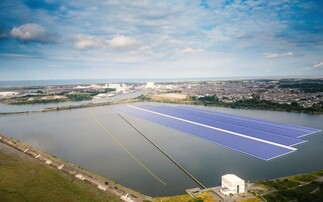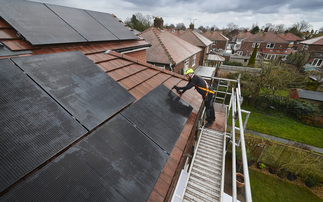Climate Change Minister pledges to knock down barriers faced by "under-deployed" commercial solar rooftop sector
Greg Barker's relationship with the UK's solar industry may have endured its ups and downs, but as the industry prepares for the New Year the Minister is confident that the "extraordinary" growth that has been achieved in the UK solar sector during his four years in office is set to continue. Meeting with BusinessGreen in his Whitehall office ahead of a major industry and parliamentary event dubbed "Solar Britain", Barker, and his dog Otto, are looking forward to 2014.
This time two years ago, the Minister for Climate Change would not have been able to talk quite so confidently about the future of a solar industry that he has long-championed. His department was locked in a legal battle with NGOs and solar power companies, after it tried to impose deep cuts to the feed-in tariff with almost immediate effect.
Supreme Court judges eventually ruled against the government, but the cuts to the tariffs still came, and the acrimonious row between government and industry, played out in the national media, only served to damage investor confidence and undermine demand for solar technologies, as many consumers and businesses shelved plans for solar installations.
When BusinessGreen asks whether Barker thinks the industry has fully recovered from this volatile period, his answer is unequivocally affirmative. "There is no comparison to the position of solar now to the industry that I found when I came into office in May 2010," he says. "It has matured, it has developed, it has deployed. We're currently at 2.7GW of solar compared to a few megawatts when I came into office and it's an extraordinary achievement by industry and government working in partnership."
But he maintains that the high level of deployment seen now would not have been possible without the controversial cuts to feed-in tariff incentives that were made in 2012. "We never would have been able to afford to deploy at that scale if we left the industry on a ludicrously high tariff and now I think there is general consensus that the greatest opportunity lies in working together towards grid parity," he says.
Barker reveals a number of plans are now in the pipeline to ensure 2014 sees a resurgence of demand for small and mid-sized solar arrays, pinpointing his greatest challenge next year as knocking down barriers for the deployment for medium-sized solar arrays, which are usually installed on commercial rooftops, or community centres, schools, and church halls.
Despite the prospect of reduced energy bills and feed-in tariff incentives, there is currently just over 100MW of capacity provided by mid-sized arrays, compared to 1,700MW of small-scale and 1,000MW of large-scale projects. In contrast, in Europe, mid-sized installations account for almost half of the market for solar.
"My greatest challenge for 2014 in solar is to really generate that mid-sized market," Barker declares, arguing that more has to be done to encourage businesses to embrace the technology. "I can see the under-deployment and I want to turn that around and there are a number of very specific steps we're taking to achieve that."
The industry has repeatedly raised concerns that the current financial incentives for mid-sized solar arrays with between 250kW and 5MW of capacity is simply not attractive enough for investors. But Barker hints that his new solar strategy is more likely to tackle non-financial barriers than dish out an increase in incentives.
He touts a "big ticket" item that will aim to encourage owners and users of commercial and industrial facilities to invest in solar, noting that currently many commercial tenants are reluctant to invest in a 20-year feed in tariff contract if they are only renting out the property on a five-year basis. Barker says one solution would be to copy the current German model, whereby companies leasing a site get the tariff and can actually pick up their system and move it to another building if they relocate.
However, experts warn there are a number of other barriers the government will need to address if it is to drive investment in this segment of the solar market. For example, industry insiders warn that in the community sector, churches and village halls are struggling to qualify for the higher feed-in tariff rate because old buildings often fail an energy performance assesment. The Solar Trade Association (STA) is calling for standards to be relaxed for old buildings to help stimulate deployment in a sector that sees significant pent up demand for solar technologies. Similarly, the STA is also urging the government to clear up the confusion about whether mid-sized solar projects need planning permission or are classed as permitted development. Some schemes can spend months ping-ponging between Ofgem and local authorities which have opposite views on the matter.
Whether Barker succeeds in addressing all of these issues remains to be seen, but he maintains that boosting the mid-sized solar market is "top of his to-do list" for the solar sector next year.
Second on his list of priorities is a move that he hopes will bolster the domestic solar market and help the oft-criticised Green Deal energy efficiency scheme at the same time. When the government agreed to the "Big Six" demands to water down the Energy Companies Obligation (ECO) energy efficiency policy last month, DECC also quietly introduced a series of changes to the Green Deal designed to drive demand for both energy efficiency improvements and onsite renewable energy technologies.
Under the new plans, anyone moving house between 2014 and 2017 could receive up to £1,000 to help fund energy efficiency measures; private landlords will be eligible for a new scheme designed to help them improve the energy efficiency of their properties; schools, hospitals and public sector buildings will be able to access a £90m funding pot to install new energy-saving measures; and funding for local authorities to carry out street-by-street Green Deal improvements will be quadrupled to £80m.
Significantly, solar power is included in the list of measures that can contribute to a building's energy efficiency and Barker is confident the Green Deal policy changes will help drive the market for solar technologies next year.
However, while Barker remains a champion of solar technologies, he makes clear he is not a fan of "monster solar farms" located on greenbelt land. Last month, he wrote to council chief executives pledging to "crack down" on inappropriate developments in the countryside and he makes no apologies for what has been seen in some quarters as increased government hostility towards large-scale solar projects.
He warns the industry that poorly sited projects could undermine the popularity the solar industry as a whole currently enjoys - DECC's most recent public attitudes tracker put solar as the most popular energy generation technology in the UK, with 81 per cent of respondents backing it. "I do not want to see and I will not stand by and see large solar farms being built on landscapes that is going to upset communities and that turns the tide against solar," Barker says. "We're very lucky, there's very high support for solar and I want to keep it that way. We have to be very sensitive to landscapes and communities and to the countryside and just making sure it's appropriate."
He acknowledges there are many good examples of large solar farms being deployed at disused industrial sites or air fields, but ultimately feels the real potential is in the mid-sized market.
It is a position that is likely to be welcomed by the growing numbers of businesses keen to deploy rooftop solar technologies, many of whom will share Barker's confidence that 2014 will be a good year for UK solar.










